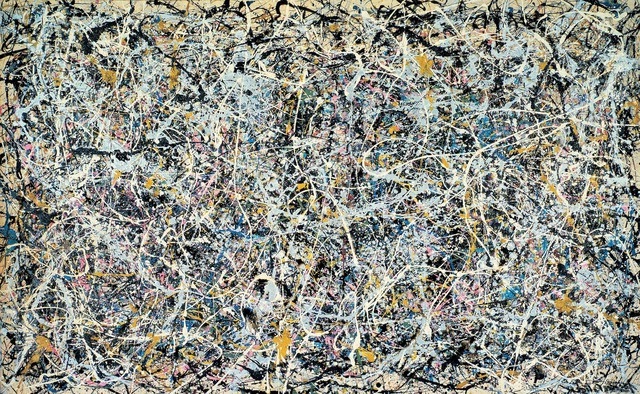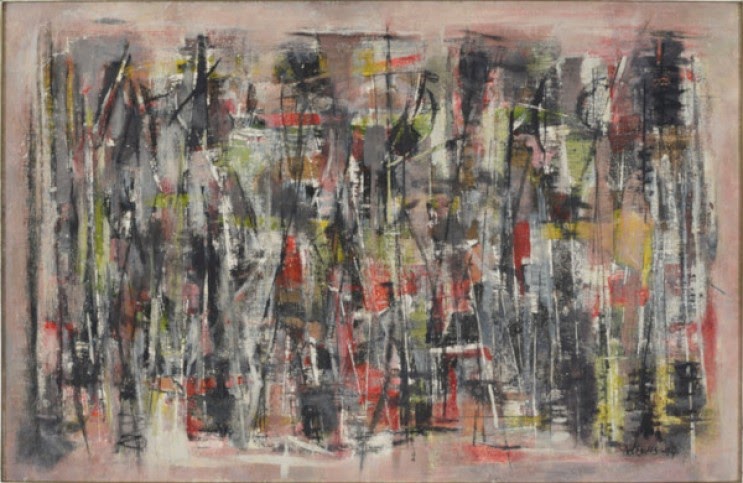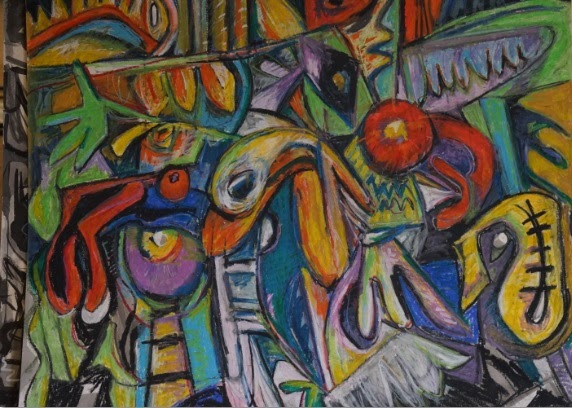Image courtesy of Los Angeles Times.
If life was a canvas, does it feel like disproportionate shapes, belligerent splatters, crowded composition, and dots that don’t make sense? Welcome to the club. With this outlook on life or the resonation of this imagery, likely shows a level of anxiety. These are not issues that the painter can just gesso over and start anew, but they have to work with the permanent trace of stressors and unexpected things life throws to create a beautiful masterpiece.
Abstraction is an apt style to describe what you may be going through because it prioritizes the story of the artist to interpret the art. Abstraction tells the story of the piques and valleys that you have been through. Additionally, Mollie Eisenberg says,“without that kind of abstract and figurative thinking it’s hard to have a grasp on the reality of being afraid of a system of power that’s intangible.”
Furthermore, you may feel like you create a blueprint for how you want your life to look but anxiety keeps on getting you down and messing with the goals that you have. The closer you get to wholeness you feel like you are constantly knocked down. The best way to cope with anxiety is to not stay in a rut, but take action, as the artist in your own story, to make your life what you desire.
Typically, anxiety is very chaotic. It creates paralysis by making you feel like you are helpless because you are too busy concentrating and obsessing over the hypotheticals, the realities of today, or future outcomes. Oftentimes the reaction is to do nothing about it. However, there are many actionable things that you can do to be productive and stop doing the Sisyphus journey of pushing a rock uphill. There is better for you and we want you to enjoy health and true peace of mind. Therefore, we have provided the following for your mental health and healing:
- What to Do When Things Do Not Go Your Way–Releasing Control of the Situation
- Actions to Decrease Anxiety and Cope With This Condition Effectively
- Planning for the Future Encounters With Anxiety

Relinquishing Control of What You Cannot Control
Navigating Difficult Situations
Abstractionists wanted their brushstrokes to show their unfiltered psyche by reverting to elemental forms. Undoubtedly they had an idea of what their composition would reflect, but there are probably moments in which the paint smears or dribbled in an unexpected way. They turn those beautiful moments that they do not have control into a masterpiece. In the same way, anxiety is caused by moments where a person has lack of control in a situation. Boom somebody just laid on you something that shakes your world and in an attempt to regain control, your brain starts fighting itself. Anxiety has many different manifestations: physical, cognitive, and emotional effects, such as shortness of breath, panic, sweating and trembling, and overwhelming feelings.
According to Anxiety and Depression Association of America, it recommends that you control what you actually have power over, which is grounding yourself in the present. First regain control of your breathing by inhaling and exhaling at a more even pace. Once you do that and make sure you are physically safe, take time out of what you were doing, practice mindfulness, exercise, count to ten, take a nap, laugh, monitor your triggers, or talk to someone. All of these actions are active verbs, which means that after you settle your breathing you need to act. For instance, if your anxiety is about getting something done by a deadline, the best way to get rid of that anxiety is being productive, rolling up your sleeves, and getting to it. Doing is the only thing to help with your anxiety, otherwise you will lodge yourself deeper and deeper into feelings of stress, despair, and anxiety.

Action Packed Steps For Success
Productively Dealing With Feelings of Anxiety
You hit the rut again, but this time you are prepared by being ready to take action. Instead of thinking about it as working to fight your anxiety, view it as working with it. Anxiety is a condition that most people sustain during their entire lifetime if diagnosed, so the trick is managing it and using productive coping mechanisms. Actually, anxiety deduces that you are a thoughtful and contemplative person that cares about their past, present, and future. We are not saying you should parade your anxiety around or that its symptoms are a good thing, but we are saying that this is the way that you are wired so the trick is to work with it. Here are some tips and tricks that will spur you into action to cope with your anxiety:
- Question your negative thought patterns. These are some great questions to start with: Is this really that bad? Are you overreacting? Where is this feeling coming from?
- Figure out what is bothering you or triggering your anxiety and decide whether to avoid it or face it head-on with a plan of action (tracking this with a journal is likely to help)
- Focus on what you can change in a situation. Make a list of the different things to deescalate a situation, such as making your environment less stressful, choosing which friends to be around that will not pull you into their negativities, eat well and drink water, and create goals to help you through it.
- Cultivate an attitude of gratitude. An example of something that is helpful is think about how much you have grown and changed for the better since your previous year self or think about the affirmations you would give your 15-year-old self because of how much you have changed and grown.
- Divert your energy to something that is less anxiety provoking. Maybe for you this is exercise, prayer, organizing your house, meditating, or watching a movie.
- Invest in your vessel. Make sure that your body is well rested, hydrated, and fit. Bodily functioning gone awry can make the body revert into anxious symptoms more easily.
- Utilize aromatherapy because it can activate calming receptors in the brain. This simple action can change how you are feeling. Some ways to add aromatherapy in your life is by taking bubble baths, lighting a candle, using heating pads with scents in them for your body, using an oil diffuser, or putting some essential oils on your bed to help you when you sleep.

‘Step Back and Admire Your View’
Cultivating a Holistic View and Engaging in Next Steps
Long term anxiety may be caused by a stressful work or home environment, racial trauma, hereditary conditions, cocktails of medications, phobias, and caffeine intake. Make sure to grapple anxiety at the root by taking action to change these overlying conditions if you are able. There are many things that trigger anxiety and we want you to brace the future of how your condition may persist.
While it may be easy for anxious people to dwell on future problems, we encourage you to make a plan for future panic attacks or feelings of anxiety to stop the pattern of these instances derailing you. Some of these plans may include having hotlines in your back pocket, finding a therapist that works for you, taking diet supplements to make sure that you do not have a chemical imbalance, trying Cognitive Behavioral Therapy (CBT) to stop negative thought patterns that you may be developing, creating a plan for medication and therapy visits with your health provider, maintaining a journal to write out your thoughts, and track mood changes with apps like Moodpath. Whatever method you and your health professional pursue is the right way to take action for you and we are excited that you are on the path to wholeness.
Put the paint brush in your hand and flow with the unexpected bumps or splatters. At first, it may look ugly but it is sure to turn around by your actionable steps towards success. Even the famous rapper, J. Cole, says,“there is beauty in the struggle, ugliness in the success.” Make your canvas what you desire by embracing the hard moments and making it beautiful.
